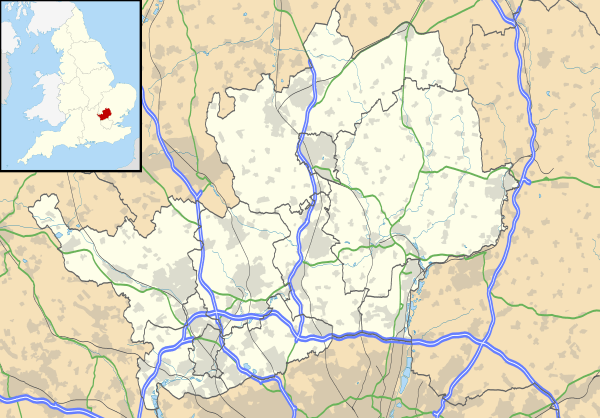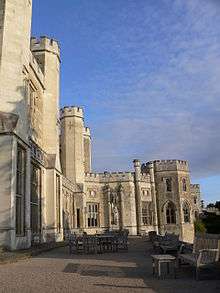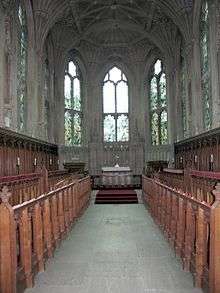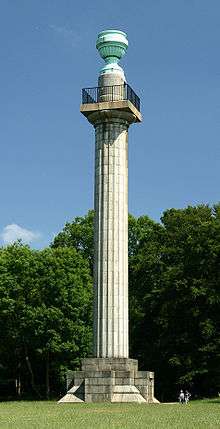Ashridge
Ashridge is a country estate and stately home in Hertfordshire, England in the United Kingdom. It is situated in the Chiltern Hills, an Area of Outstanding Natural Beauty, about 2 miles (3.2 km) north of Berkhamsted and 23 miles (37 km) north west of London. The estate comprises 5,000 acres (20 km2) of woodlands (known as Ashridge Forest), commons and chalk downland which supports a rich variety of wildlife.
| Ashridge | |
|---|---|
| Hertfordshire, England, UK | |
 Ashridge House | |
 The Bridgewater Monument | |
 Ashridge Location in Hertfordshire | |
| Coordinates | 51.7996°N 0.5594°W |
| Grid reference | SP975135 |

Today, Ashridge is home to Hult International Business School's Ashridge Executive Education program, as it has been since 1959. The estate is currently owned by the National Trust.
History
Ashridge Priory
In mediæval times Ashridge was the location of Ashridge Priory, a college of the monastic order of Bonhommes founded in 1283 by Edmund, 2nd Earl of Cornwall, who had a palace here.[1] During the Dissolution of the Monasteries the priory was surrendered to Henry VIII who eventually bequeathed the property to his daughter, Elizabeth. The priory church was demolished during the reign of Elizabeth I.[2]
The Egerton family
In 1604 the estate became the property of Sir Thomas Egerton.[3] Egerton's son, John Egerton, was created 1st Earl of Bridgewater on 27 May 1617. In 1800 the estate was redeveloped as the Bridgewater residence by Francis Egerton, 3rd Duke of Bridgewater. The Duke demolished most of the Priory and the present house was constructed between 1808 and 1814. The 3rd Duke of Bridgewater was buried in the Egerton family vault in Little Gaddesden Church, close to Ashridge.[4]
In 1848 the estate passed to the Earls Brownlow, another strand of the Egerton family,[5] and then in 1921 it was split, with the land passing to the National Trust, while the house and garden was acquired by speculators.[6]
Conservative Staff College
In 1928 Urban Hanlon Broughton purchased the house as a gift for the Conservative Party intended to commemorate Bonar Law.[6] In July 1929 Ashridge opened by Stanley Baldwin as a College under the governance of the Bonar Law Memorial Trust (BLMT).[7] The BLMT was charged by its Founding Deed to pursue the following goals, namely
(a) honouring the memory of a great statesman, (b) the preservation of the house and grounds as an historic building, (c) to create an educational centre ... (d) to train lecturers, speakers and writers to further the study of the subjects outlined above (e) ... provide lectures and/or discussions on these subjects open to the public or for those who had paid fees to attend, (f) ... provide a supporting staff, (g) to allow boarding by those attending the lectures and discussions.[8]
For the next fifteen years the college, the full title of which was the Bonar Law Memorial College, Ashridge was to act as a school for Conservative intellectuals creating, in their own words, 'Conservative Fabians', and as a 'College of Citizenship' for 'the general education of the electorate'. Associated with the College were regional or county circles or clubs, such the Ashridge Dining Club in London; their activities were reported by The Ashridge Journal.[9] In 1954 its Deed of Foundation was changed by Act of Parliament, and Ashridge was 're-founded' as an educational charity. In 1959 it became a Management College, which it remains today.[10]
Hult International Business School
In 1959 Ashridge College was re-launched to provide management training, and was named Ashridge Business School.[11] In 2015, Ashridge Business School operationally merged with Hult International Business School, an American business school with campuses in seven cities around the world. As part of the merger, Ashridge Business School changed its name to Ashridge Executive Education.[12]
Estate
Ashridge House


The 7th Earl of Bridgewater commissioned the architect James Wyatt to build the neo-Gothic Ashridge House as his home. Wyatt died in 1813 and the project was completed the following year by his nephew Jeffry Wyatt (later known as Sir Jeffry Wyatville).[13] The present house is regarded as one of the finest examples of early Gothic Revival architecture and is now a Grade I listed building.[14][15][16]
Ashridge house was built on the site of the 13th-Century priory building which had been demolished in 1800. Some parts of the old priory were incorporated into the house by James Wyatt, including the undercroft of the monastic refectory, featuring two aisles, seven bays and a rib-vaulted ceiling, which he repurposed as a beer cellar below the dining room and drawing room.[17]
The mansion is built of ashlar faced with Totternhoe stone with a castellated parapet and low-pitched slate roofs. It features a variety of casement windows including pointed arch and ogee lights typical of the early Gothic Revival style. Before his untimely death, James Wyatt completed the north-facing front entrance and the central block, containing the state apartments and western courtyards. Jeffry Wyatt added private apartment blocks at an angle to the main building and an orangery with a turret in 1815–17. The main entrance features a projecting porte-cochère and octagonal turrets, added by Jeffry Wyatt c.1814.[17]
Inside the mansion are a number of richly decorated state rooms; of the interior features, only the hall, the staircase tower and the chapel are Gothic in design. The high staircase hall features a stone stair with iron railing, surrounded by niches containing statues by Sir Richard Westmacott. At the centre of the fan-vaulted ceiling is a large dial connected to the weather vane on the roof which displays the current wind direction. The Brownlow Hall contains a giant frieze of the goddess Venus surrounded by putti with an armorial centrepiece and three early-Twentieth Century murals. Redecoration of the interiors was commissioned by Lady Marian Alford and executed in the neoclassical style in 1855–63 by Sir Matthew Digby Wyatt, including a replica of Guido Reni's Aurora ceiling and aedicular door surrounds. Among the alterations carried out after the conversion of the mansion into a college, the conservatory was altered by Clough Williams-Ellis in 1919 to form a dining-room. The boundary between Hertfordshire and Buckinghamshire originally passed through the dining room, though the house is now entirely in Hertfordshire.[15][17]
The house incorporates a Gothic Revival Chapel designed by James Wyatt, completed by Jeffry Wyatt in 1817. The most notable exterior feature of the chapel is its spire which was demolished in 1922 by Lord Brownlow as it had become structurally unsound. The spire which can be seen today is in fact a fibreglass replica which was erected in 1969. The chapel interior features a pair of Fourteenth-Century carved doors, fan-vaulted coving supporting a canted panelled ceiling; a set of carved oak choir stalls designed by Jeffry; and an array of Rayonnant lancet windows.[15] The windows were originally fitted with stained glass panels depicting scenes from the Bible; the glass was imported by the 7th Earl from Germany, having been originally designed in the Sixteenth Century for Steinfeld Abbey and Mariawald Abbey. The glass was auctioned off at Sotheby's in 1928 and acquired by the Victoria and Albert Museum.[18] One glass panel featuring the Blessed Virgin was placed in the nearby Church of Ss Peter and Paul at Little Gaddesden; another, depicting St Peter was in Christ Church, Croydon in London. Beneath the chapel is a vaulted medieval wellhouse with a 224-foot (68 m) well.[17]
Part of the estate became Ashridge Golf Club in 1932, and had Henry Cotton as its club professional in the late 1930s, including his most successful year 1937.[19]
During the Second World War, the building and the lawn in front of it was used as a secondary site for Charing Cross Hospital.[20]
Outside the house stands the timber-frame and brick Fourteenth-Century Monks' Barn in the Monks' Garden. It was remodelled in 1816 by Jeffry Wyatt who added a covered walkway. In 1884 Mathew Digby Wyatt added the red brick Fern House.[17]
The house has housed the Ashridge Executive Education program, of Hult International Business School, since 1959.[21]
Bridgewater Monument

The Grade II* listed[22] Bridgewater Monument (grid reference SP970131) is a tower on the Ashridge estate, built in 1832 in memory of Francis Egerton, 3rd Duke of Bridgewater (1736–1803), "the father of inland navigation".[23]
Ashridge Commons and Woods
Ashridge Commons & Woods (grid reference SP975135) is a 640.1 hectare (1581.7 acre) Biological Site of Special Scientific Interest. The site was notified in 1987 under the Wildlife and Countryside Act 1981 and lies on the Buckinghamshire and Hertfordshire border and is home to much semi-natural vegetation. As well as this, the site has extensive areas of woodland, grass and plantations. The site supports bird-breeding community which as both country and national different species of birds.[24] Ashridge Woods are also well known for their Bluebell woods.[25]
Filming location
Ashridge Common has been featured many times in film and television series due to its distinction as an area of natural beauty. Scenes for Plotlands, Sleepy Hollow, Jonathan Creek and Harry Potter and the Goblet of Fire were filmed in Ashridge's Frithsden Beeches wood.[26] The Ashridge House, which is now Ashridge Business School has been featured in films such as The Dirty Dozen.[27]
References
- "according to Tanner", from the Boni Homines article in the Catholic Encyclopedia
- of Ashridge – Ashridge Business School, Accessed 17 June 2014
- Sanecki, K. A. pg 25
- Bridgewater Chapel at Little Gaddesden Church, accessed 24 July 2015
- Sanecki, K. A. pg 6
- Sanecki, K. A. pg 73
- "Bonar Law College", Daily Herald, 2 July 1929 page 7
- Berthezène, Clarisse (Spring 2005). "Ashridge College, 1929-54: a glimpse at a Conservative intellectual project". Contemporary British History. 19: 79–93. doi:10.1080/1361946042000303873.
- "The London Ashridge 1937 Club". The Ashridge Journal: 45–46. Autumn 1937.
- A glimpse at the archives of a Conservative intellectual project
- Rural Heritage Society Archived 5 March 2012 at the Wayback Machine
- "Governance". Ashridge.org.uk. Archived from the original on 2 April 2016. Retrieved 5 June 2016.
- Sanecki, K.A., pg 30
- Historic Houses Association Archived 27 December 2009 at the Wayback Machine
- Pevsner pp.238–240
- Historic England. "Grade I (1348442)". National Heritage List for England. Retrieved 10 April 2013.
- Historic England. "Ashridge Management College (1348442)". National Heritage List for England. Retrieved 13 August 2012.
- "Stained glass from Mariawald Abbey". Victoria and Albert Museum. Retrieved 13 August 2012.
- Ashridge Golf Club
- WW2 People's War
- "History and Heritage". Ashridge College. Archived from the original on 23 December 2012. Retrieved 13 August 2012.
- Historic England. "Grade II* (1078046)". National Heritage List for England. Retrieved 10 April 2013.
- Duke of Bridgewater Monument at Ashridge Estate Visit East of England
- "Ashridge Commons and Woods" (PDF). English Nature. Archived from the original (PDF) on 20 March 2009. Retrieved 24 February 2008.
- "Ashridge lavender forest". BT Images. Retrieved 24 January 2014.
- "Special trees and woods – Frithsden Beeches". Chilterns Conservation Board. Archived from the original on 13 June 2011. Retrieved 16 February 2010.
- The Dirty Dozen at IMDb
Sources
- Pevsner, Pevsner (2002). Cherry, Bridget (ed.). Hertfordshire (2nd ed.). New Haven: Yale University Press. ISBN 9780300096118.
- Sanecki, Kay (1996). Ashridge – A Living History. Phillimore. ISBN 978-1-86077-020-3.
Further reading
- "Ashridge Management College, Little Gaddesden". British Listed Buildings. Retrieved 12 August 2012.
- Berthezène, Clarisse (2015). Training minds for the war of ideas. Ashridge College, the Conservative Party and the cultural politics of Britain, 1929-54. Manchester: Manchester University Press. ISBN 978-0-7190-8649-6.
- Coult, Douglas (1980). A Prospect of Ashridge. Chichester: Phillimore. ISBN 978-0-85033-360-2.
External links
| Wikimedia Commons has media related to Ashridge. |
.png)